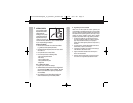
Step 2:
Insert batteries in mouse
The mouse requires two NiMH AAAbatteries.
1. Remove the battery compartment cover on the bottom of the
mouse.
2. Insert the two NiMH AAA batteries in battery compartment.
3. Replace the battery compartment cover (1) on the bottom of the
mouse.
CAUTION:
Risk of explosion if battery is replaced by an incorrect
type. Dispose of used batteries according to instructions. Refer to
"Important Battery Information" for disposal instructions.
Inserting batteries in keyboard
The keyboard requires two alkaline batteries (AA).
• Remove the battery compartment cover (1) on the bottom of the
keyboard by pushing it in the direction of the arrow.
• Insert two AA batteries. The illustration in the battery
compartment (2) shows how to insert the batteries properly.
• Replace the battery compartment cover by pushing the locking
lug (2) under the battery compartment.
Note: Please do not push the channel setting button (3) at one
side of the battery compartment cover. It may cause the channel
or ID to change. It is the same to mouse and keyboard.
D. Servicio al cliente de Fellowes
Nuestros representantes de soporte técnico están a su disposición para
ayudarlo a resolver sus problemas. Haremos todo lo posible para resolver
el problema, o bien, apoyaremos completamente su decisión de obtener un
reembolso. (Por favor, guarde una copia del recibo de venta fechado
como comprobante de la compra). Para solicitar soporte técnico en América
del Norte y América del Sur, llame al 1-888-FEL-TECH o envíenos un
mensaje de correo electrónico a: feltech@fellowes.com. Para solicitar
soporte técnico en el Reino Unido, llame al 00800-1810-1810 o envíenos
un mensaje de correo electrónico a: cs-uk@fellowes.com. Si tiene
preguntas acerca de la garantía o el funcionamiento de este producto,
llame al 1-800-945-4545.
GUÍA PARA EL USO SALUDABLE DEL EQUIPO
A. Advertencia sobre la salud
El uso de un teclado o mouse puede estar relacionado con trastornos o
lesiones graves.
Al usar una computadora, ocasionalmente puede sentir molestias en las
manos, los brazos, los hombros, el cuello u otras partes del cuerpo. No
obstante, si tiene síntomas tales como molestias, dolores, vibraciones,
malestar, hormigueo, ardor o rigidez persistentes o recurrentes: NO
IGNORE ESTOS SIGNOS DE ADVERTENCIA. CONSULTE A UN PROFESIONAL
MÉDICO DE INMEDIATO. Estos signos pueden evidenciar trastornos
musculoesqueléticos como el síndrome del túnel carpiano o la tendinitis, y
deben ser tratados por un profesional médico.
5
MicroCordlessKybrd_3L_9893401_061808.qxd 6/27/08 8:47 AM Page 30


















